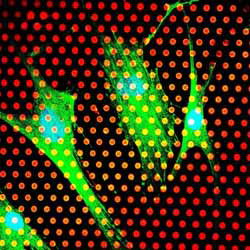Monitoring the subcellular world for better health care
A cell's substratum (underlying surface) comprises a series of pillars whose degree of bending is directly related to the forces of the cell coming into contact with them at focal adhesion (FA) points. More information is needed about these forces; characterising cells and related biological processes is essential to advances in healthcare. The development of monitoring and diagnostic devices to realise such a goal relies on better understanding the interactions between biological and non-biological systems. The 'Development of a single cell based biosensor for subcellular on-line monitoring of cell performance for diagnosis and healthcare' (Cellforce) project set out to develop intelligent medical equipment sporting nanotechnology biosensor-based integrated systems. The EU-funded project's activities generated much knowledge in various scientific fields, while the ability to observe cellular forces yielded information about cellular physiology. For example, it was discovered that the forces cells can transmit to surfaces are actually much smaller than originally expected. Existing materials and techniques are not sufficient for defining and producing optimal pillar characteristics for an industrial application biosensor. Project partners determined this on the strength of evidence showing that cells adapt their forces in relation to the stiffness of the substratum. As such, physical, biological and technical limitations prevented Cellforce from delivering its envisioned biosensor. However, study outcomes were successful in other ways: knowledge gained resulted in enhanced sensory equipment for cell cultivation and detection, and a better understanding of the cell adhesion of corresponding proteins. Further research in to the development of the envisioned biosensor has the potential for application in various fields of healthcare. This will be important for, among others, characterising specific cells in order to optimise patient-specific treatment.







